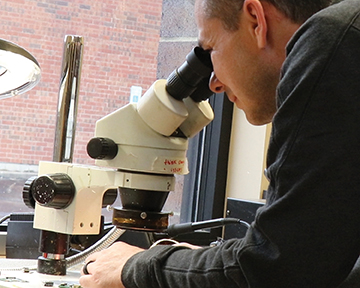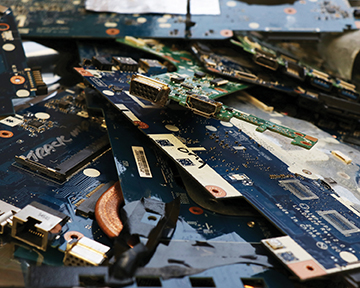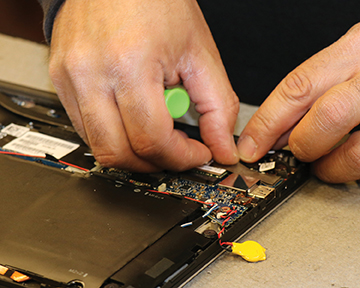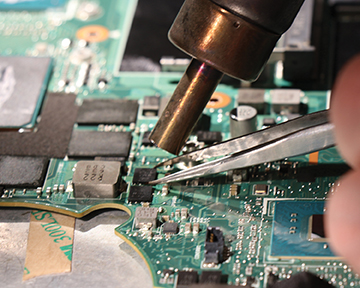The Benefits of Component – Level Board Repair
By Jane Washburne, VT Services
The life cycle of electronic and digital devices seems to be getting shorter and shorter. The more that people carry their laptops, cell phones, and tablets around, the more these devices are dropped, exposed to the sun, sat on, damaged by water or other liquids, and abused in other absurd ways. We have many unbelievable stories we can tell! Many school IT directors, operation managers, and even some families have storage closets, cabinets, and nooks and crannies full of equipment that is broken and unusable while their budgets and resources are limited for replacement. The question is what’s to be done with this equipment?
Component-level repair is a solution that everybody needs and yet few people know exist or have become comfortable enough to give it a try. On its very basic level, component level repair requires technicians with unique skills and equipment to find the problem the device is having and fix it. This eliminates the need to replace parts that are not broken or discard the whole device and purchase brand new. Logic board components consist of a group of IC’s (integrated circuits) coming together to create one logic board layout. Support components for each IC consist of transistors, capacitors, resistors, mosfets, step-up and step-down power control, and I/O ports (USB, HDMI, D-Sub, etc).
When talking with Sandy Zimmerman, President of VT Services, it is very clear that her and her team have such an enthusiasm for component-level board repair and the value it has brought to many of their K-12 clients. Over the last few years, more schools are going 1:1 ratio with Chromebooks with their students. The cost of replacement boards for these units would typically exceed the value of the unit; therefore, making the defective Chromebooks practically disposable. With the cost-effective component-level board repair, it has made it a whole new ball game! Schools are able to keep devices in fleet longer and it is making a huge impact on their budget and bottom line.

Component-level hardware technicians keep the cost of repair on a wide range of educational, enterprise, and consumer devices to a minimum, while also keeping the environmental impact at a considerably lower rate. Component-level troubleshooting, diagnosing, and repairing are key elements to what component-level repair is all about. A good technician is skilled in soldering various types of IC components safely, quickly, and effectively. Utilizing proper tools, and understanding the communication between IC components, and their support components as well as how power travels, is converted, and is carefully controlled; this gives the technician the ability to make sure the device is repaired properly. It will also allow the logic board to function as the manufacturer of the device intended, sometimes even pinpointing manufacturer flaws along the way. Joe Marchesky, Director of Research and Development at VT Services, indicates that with the capability of replacing THT (Through Hole Technology), SMT (Surface Mount Technology), or BGA (Ball Grid Array), the technician should be able to get the device back up and running as fast as possible, and with a high level of quality and integrity. Our years of experience allows us to make these assessments with confidence and accuracy.
In addition to the previously mentioned benefits, most component-level repair companies offer a 90 day warranty on the repair which exceeds most part vendors’ warranties by 60 days. This extensive warranty period gives our customers peace of mind.

When comparing the cost of component-level repair there are more things to consider than just the monetary aspect. When the device is not working, that is considered downtime and downtime is money lost. If that device ends up in the local landfill, that is environmental cost. By using component-level repair, all three versions of cost are significantly cheaper compared to the cost of replacing an entire logic board. Right now, the cost of a specific major Chromebook manufacturer logic board, if purchased directly from the manufacturer, is about $298.00. If it also happens to be on backorder, that adds another cost - the cost of downtime. When VT Services fixes the same logic board the price ranges between $40 and $70. That is less than one third the price of the new board and it keeps the old board in use longer and out of the landfill. And, because the repair takes place in house, turnaround time is less than 24 hours instead of waiting on a back ordered part that could take weeks. That is the ultimate goal of component-level repair.
Service centers, like VT Services, that offer component-level repair can extend the life of a device by several years. For example, the computers that are made for gaming have an end of life at about three years. Around that time, some manufacturers will stop production of the parts and if the unit goes down the consumer can try to find a part online somewhere or they would just have to buy a new one. By taking the computer to a component-level repair service center, the consumer could get the part fixed and be able to continue using the computer.

E-Waste, also called electronic waste, is the name for electronic products that have reached their end of life cycle. The impact that these devices have on the environment goes much further than just piling up in the landfills. Some of these devices contain toxic materials such as barium, chromium, lead, nickel, and zinc which can get into the ground, water, and air and cause health issues to people who come into contact with it. Component-level repair helps to push back that end of life date and keep the electronic devices in circulation and out of landfills. It truly is summed up with the Recycle, Repair, Re-Use triangle. Jodi Ortiz, Project Development Manager at VT Services, has attended many conferences over the last couple of years and in speaking with the many recycling companies, has learned that the recycling companies are now investing in component-level repair as well and reselling entire devices instead of breaking them down to the recycling components and disposing of the non-recyclable items. It has allowed the recycling companies a whole new outlet to increase revenue and be more “Green” at the same time. It truly is a win – win!
There is less down time sending in a device for repair versus having to wait for a replacement part from the manufacturer and that is if the replacement part is even still available. Many times the original manufacturers will stop production on boards to make room for newer models coming out. It becomes difficult to find the right pieces and component-level repair becomes the best option to keep the device running. Pat Robert, Director of Business Development at VT Services, has indicated over the past couple of years certain manufacturers have jumped on board with component-level board repair realizing the many benefits. Our commitment to constantly keeping up with the technological changes allows us to stay ahead of the trends in the market.

Logic boards are manufactured by machines which sometimes do create a flawed product. When this happens, the whole system can go down. Because of the troubleshooting process that component-level repair technicians use, those flaws can be found and corrected. Reminiscing with the Service Manager, Dan Swartz at VT Services, he recalls a good example of this was experienced back in 2012 with a particular model gaming unit. These units were having issues of overheating and it seemed to come from broken contacts. The units that came to component-level repair companies were quickly fixed and returned to their owners. Others tried, without much success to fix the problem on their own using techniques found on the internet.
Many times component level repair service centers are risk free. They offer a no charge policy for those products that cannot be fixed. Often they will also provide recycling services to make sure that the parts of an unusable device are disposed of properly and that any parts that can be reused will be salvaged and used.
There are many things that can go wrong with electronic and digital devices, from a transistor to any number of ports. Sometimes people just want to throw their hands in the air and give up, throw it all away or stick it in a closet and buy something new that hopefully will work better. Sometimes they even try to make do with a cracked screen, broken keyboard or only half of the available ports working. Component-level repair centers can make a difference on so many different levels - fast turnaround times, cost savings, and environmental savings. The solution is here, finally!
 Jane Washburne
Jane WashburneJane Washburne is a long time photographer with a degree in computer science. She has a passion for technology. She spends her time developing new techniques in digital communications. When she’s not working, she enjoys her lake, entertaining and cooking for friends and family and spoiling her 4-year-old golden doodle, Sammie.Re